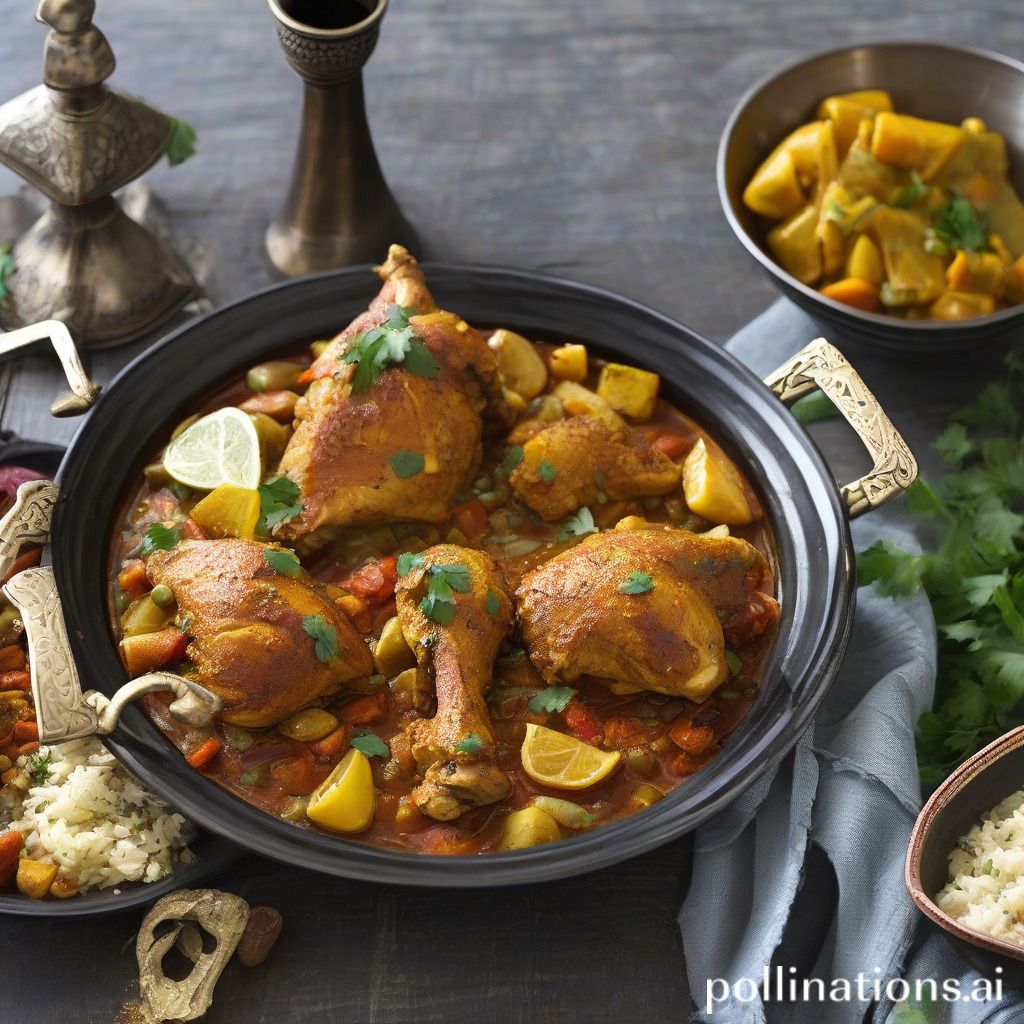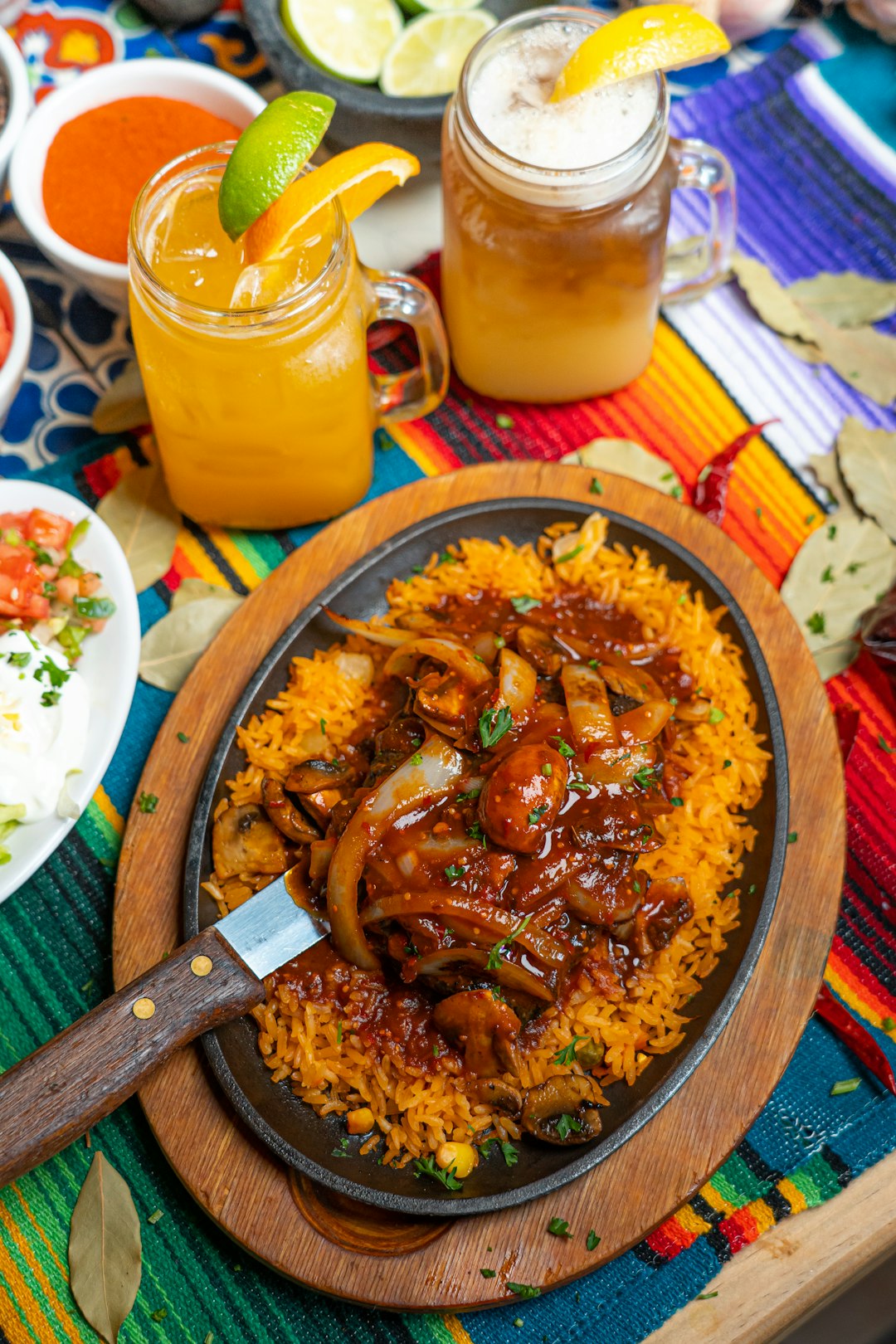Table of Contents
- Introduction
- Ingredients and key spices for Moroccan Spiced Chicken Tagine
- Step-by-step preparation and cooking techniques
- Pairing Moroccan Spiced Chicken Tagine with sides and accompaniments
- The cultural significance and origins of Tagine cooking
- Variations and adaptations of the traditional Moroccan Chicken Tagine
- Nutritional benefits and considerations of the dish
- Tips for perfecting the flavors of a Moroccan Chicken Tagine
- Serving and presentation ideas for an authentic experience
- Conclusion
- Frequently Asked Questions
Introduction
Embark on a culinary journey to the vibrant markets and aromatic kitchens of North Africa, where every dish tells a story. Mastering the Moroccan Spiced Chicken Tagine begins with an exploration of its fragrant ingredients that have traveled through time. Imagine the earthy warmth of cumin, the fiery kick of cayenne, and the delicate sweetness of cinnamon all blending together in a mesmerizing dance of flavors. Picture the rich, golden hues of saffron-infused sauce enveloping succulent chicken, dotted with vibrant apricots, plump olives, and tender onions.

Ingredients and key spices for Moroccan Spiced Chicken Tagine
Moroccan Spiced Chicken Tagine is a flavorful dish that showcases a variety of aromatic spices and fresh ingredients, creating a rich and satisfying meal. The main ingredient is, of course, chicken, typically cut into pieces to absorb the flavorful spices. Commonly used parts include thighs and legs, which remain tender and juicy during the slow-cooking process.
The key to the unique taste of this dish lies in the spices. Cumin, coriander, and turmeric provide a warm, earthy base, while ginger and cinnamon add a sweet yet zesty touch. Paprika gives the dish its rich color, and a pinch of saffron can lend an extra layer of fragrance and luxury. Garlic and onion are essential for depth of flavor, enhancing the aromatic spice blend.
Additional ingredients include preserved lemons, which add a touch of citrusy brightness, and olives for a briny contrast. Vegetables like carrots, potatoes, and tomatoes are often added, as they absorb the delicious broth and add texture. Fresh cilantro or parsley for garnishing completes the dish, adding freshness and a pop of color. Together, these ingredients create the harmony of flavors that makes Moroccan Spiced Chicken Tagine a beloved dish.
Step-by-step preparation and cooking techniques
Preparing Moroccan Spiced Chicken Tagine is a delightful culinary journey. Begin by gathering your ingredients, including chicken pieces, olive oil, onion, garlic, ginger, cumin, coriander, cinnamon, turmeric, salt, and pepper. Additional ingredients like preserved lemons, green olives, and fresh herbs such as cilantro enhance the flavors.
Start by marinating the chicken. In a bowl, combine olive oil, minced garlic, grated ginger, and spices. Coat the chicken thoroughly with the marinade, cover, and refrigerate for at least an hour, allowing the flavors to meld.
Once marinated, heat a tagine or a heavy-bottomed pot over medium heat. Add a drizzle of olive oil, then sauté sliced onions until golden brown. Next, introduce the chicken, searing each side to lock in the flavors.
After browning the chicken, add chopped tomatoes, olives, and preserved lemons to the pot. Cover with a lid and let it simmer gently for about 40 minutes until the chicken is tender and well-cooked. Stir occasionally and adjust seasoning as needed.
Serve the tagine hot, garnished with fresh cilantro. It pairs beautifully with couscous or crusty bread, making it a meal that tantalizes taste buds and warms the soul.
Pairing Moroccan Spiced Chicken Tagine with sides and accompaniments
Pairing Moroccan Spiced Chicken Tagine with the right sides and accompaniments enhances the aromatic and flavorful experience of this North African dish. One popular choice is to serve the tagine with fluffy couscous. The small granules of semolina soak up the flavorful sauce, offering a subtle texture contrast that complements the tagine’s rich flavors.
Alternatively, you might consider offering warm, crusty bread like Moroccan khobz or even a simple French baguette. This allows diners to scoop up the delicious sauce and ensures nothing from the plate goes to waste.
For those seeking lighter options, a fresh green salad with crisp lettuce, cucumber, and a zesty lemon vinaigrette provides a refreshing counterbalance to the rich spices of the tagine. Additionally, roasted or steamed vegetables like carrots, zucchini, or beets can add both color and nutritional value.
Finally, accompanying drinks such as mint tea or a glass of light red wine can elevate the meal further. These beverages complement the warm, aromatic spices naturally without overpowering the main dish.
The cultural significance and origins of Tagine cooking
The Tagine, both a cooking vessel and a dish, holds a cherished place in Moroccan culture, encapsulating centuries of culinary tradition. This iconic pot, characterized by its unique conical shape, is traditionally made from clay, allowing for the slow simmering of ingredients which results in richly flavored, tender meals. The term ‘Tagine’ also refers to the dish prepared in this vessel, prominently featuring a harmonious blend of spices, meats, vegetables, and sometimes dried fruits.
The origins of Tagine cooking can be traced back to the indigenous Berber tribes of North Africa. Over the years, it evolved by integrating culinary influences from Arab, Mediterranean, and Andalusian cuisines, ultimately becoming a staple of Moroccan households and celebrations. Each region in Morocco may have its unique twist on Tagine, utilizing local ingredients and reflecting the area’s specific tastes.
The cultural significance of Tagine lies not only in its flavors but also in its role in bringing families together. It is often served communally from the pot, encouraging those gathered to share not just a meal, but conversations and traditions that have been passed down through generations. Thus, the Tagine is more than just food; it is a symbol of Moroccan hospitality and communal life.
Variations and adaptations of the traditional Moroccan Chicken Tagine
The traditional Moroccan Chicken Tagine is a flavorful stew that typically combines chicken, preserved lemons, olives, and a rich blend of spices like saffron, ginger, and cumin. Despite its traditional roots, many variations and adaptations of this beloved dish exist, allowing for creativity and flexibility in the kitchen.
Some modern takes on the Moroccan Chicken Tagine include variations in protein, such as substituting chicken with lamb or beef for those who prefer red meat. Vegetarians and vegans can also enjoy a tagine by replacing meat with hearty vegetables like eggplant, zucchini, and chickpeas, adding texture and depth. To cater to different palates, chefs often adjust the level of spice by incorporating additional ingredients, such as harissa, a spicy chili paste that provides an extra kick.
Adaptations also include the use of seasonal ingredients, such as incorporating fresh apricots or prunes for a hint of sweetness that complements the robust spices. Additionally, with globalization, ingredients from other cuisines, like coconut milk or quinoa, are sometimes introduced to give the dish a cross-cultural twist. These variations maintain the essence of the traditional tagine while offering exciting new experiences for the modern diner.
Nutritional benefits and considerations of the dish
Moroccan Spiced Chicken Tagine is a dish brimming with flavors and a range of nutritional benefits. The primary ingredient, chicken, is an excellent source of lean protein, which is essential for muscle growth and repair. Rich in vitamins like B6 and B12, chicken supports energy production and red blood cell formation. Additionally, the dish is laden with spices such as cumin, coriander, and cinnamon, each contributing not only a unique flavor but also health benefits. These spices are known for their antioxidant properties, which can help fight inflammation and boost overall immunity.
The tagine’s vegetable components, such as onions, carrots, and tomatoes, add dietary fiber, which promotes healthy digestion and helps maintain steady blood sugar levels. The inclusion of fruits like apricots or raisins offers natural sweetness while providing additional vitamins and minerals.
However, it’s important to consider portion sizes and salt content, particularly for individuals monitoring sodium intake. Using fresh or dried herbs instead of extra salt can enhance flavor without increasing sodium levels. Overall, when enjoyed in moderation and prepared with fresh ingredients, Moroccan Spiced Chicken Tagine can be a healthy, balanced meal choice.
Tips for perfecting the flavors of a Moroccan Chicken Tagine
Creating the perfect Moroccan Chicken Tagine requires a balance of spices and cooking techniques that bring out the dish’s authentic flavors. Begin by preparing your spice mix carefully; commonly used spices include cumin, coriander, turmeric, cinnamon, and ginger, which work together to create the dish’s signature complexity. Fresh ingredients are essential, so choose the highest-quality chicken and vegetables you can find. Adding a touch of saffron can elevate the aroma and depth of flavor.
Another key tip is to allow ample time for the tagine to simmer. Slow cooking in a traditional clay pot helps tenderize the chicken and meld the flavors, creating a rich and aromatic dish. Incorporating preserved lemons and green olives towards the end of the cooking process can add a burst of tanginess that complements the spices perfectly. The use of fresh herbs such as cilantro and parsley just before serving can enhance the freshness and vibrancy of the tagine.
Lastly, it’s essential to taste and adjust as you go. A little tweak here and there with salt or a squeeze of lemon juice can make all the difference. Enjoy your Moroccan Chicken Tagine with fluffy couscous and savor the delicious blend of flavors.
Serving and presentation ideas for an authentic experience
For an authentic experience when serving Moroccan Spiced Chicken Tagine, presentation is key. Start by choosing a traditional tagine dish if possible. These earthenware pots enhance the cooking process and make for a beautiful serving vessel. Place the tagine in the center of the table and remove the conical lid to reveal the colorful stew beneath. To truly transport your guests to Morocco, accompany the tagine with classic Moroccan sides, such as fluffy couscous, warm flatbreads like khobz, or fresh salads featuring ingredients like oranges and olives. You can garnish the dish with a sprinkle of freshly chopped cilantro or parsley for added color and flavor.
Serve the meal family-style, encouraging guests to help themselves directly from the tagine. Consider setting the table with Moroccan-inspired decor, such as intricate lanterns and colorful tablecloths, to create an immersive ambiance. To enhance the sensory experience, play traditional Moroccan music softly in the background. The aroma of the spices mingling with the music will transport everyone to the vibrant markets of Marrakech, making the meal not just about taste, but a complete cultural experience.
Conclusion
Mastering the art of Moroccan Spiced Chicken Tagine unveils a culinary world filled with vibrant flavors and rich cultural heritage. This dish not only tantalizes taste buds with its harmonious blend of spices like cumin, coriander, and cinnamon but also invites mealtime traditions that foster community and warmth. From selecting the freshest ingredients to perfecting the slow-cooked medley in a traditional tagine, creating this dish is a rewarding journey into the heart of Moroccan cuisine.
Whether served with couscous and a refreshing salad or enjoyed with friends and family, Moroccan Spiced Chicken Tagine offers not only a meal but an experience. The variations and adaptations ensure it caters to diverse palates, while its nutritional benefits make it a wholesome choice. Embrace the authentic preparation methods and creative presentation ideas to elevate your dining experience.
For those eager to dive deeper into a world of diverse and flavorful chicken recipes, consider expanding your culinary library. Explore ‘The Chicken Bible: Say Goodbye to Boring Chicken with 500 Recipes for Easy Dinners, Braises, Wings, Stir-Fries, and So Much More’ (buy now on Amazon) to transform everyday meals into extraordinary culinary delights.
